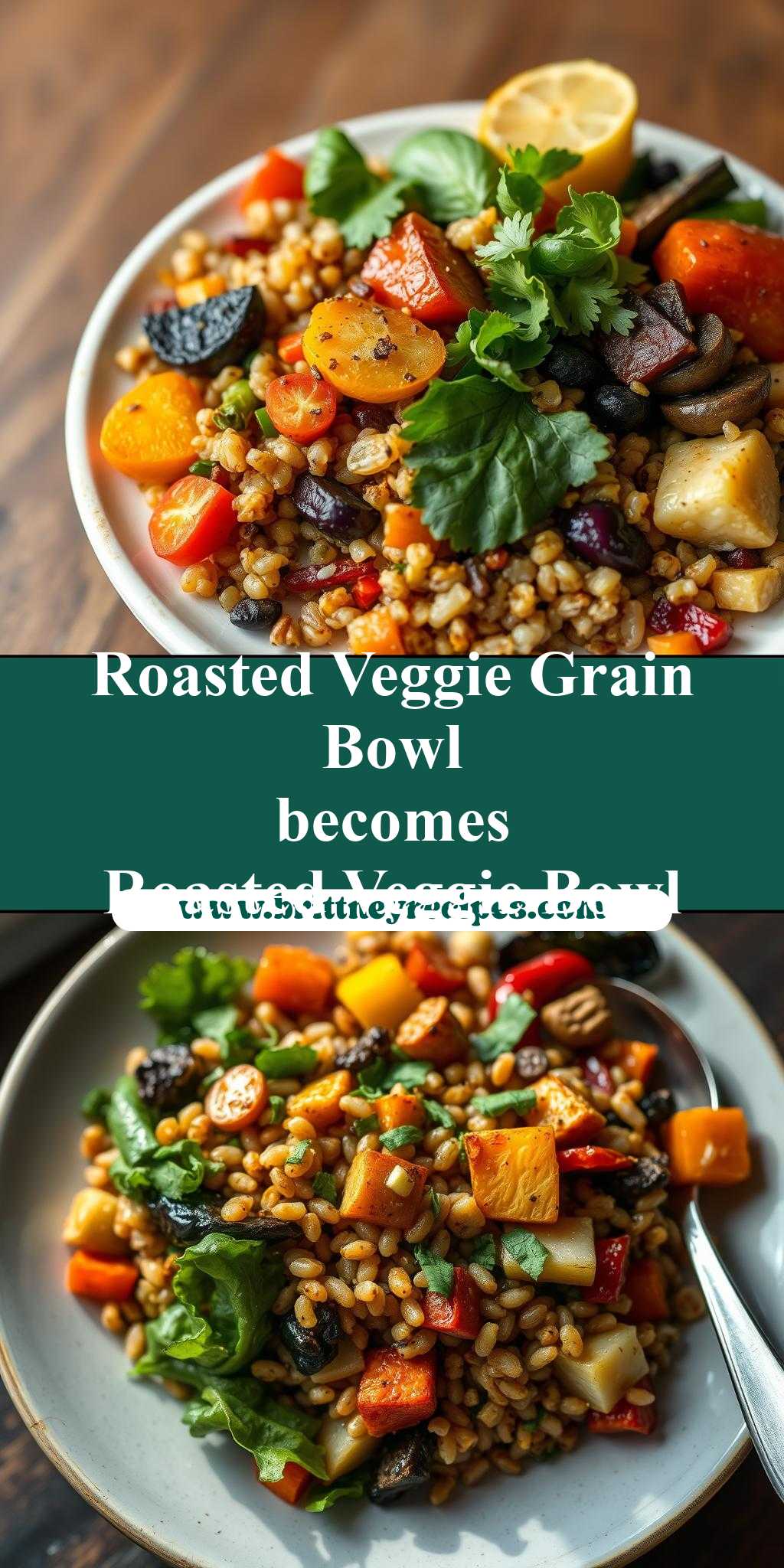What makes a perfect weeknight dinner? A hearty roasted veggie grain bowl filled with tender sweet potatoes and fluffy quinoa, a quick and easy homemade solution for busy families. Roasting brings out the best flavors in this family favorite dish. Save this idea for a deliciously easy meal solution.
Roasted Veggie Grain Bowl
Introduction
The Roasted Veggie Grain Bowl is a culinary masterpiece that embodies the perfect blend of ease, flavor, and creativity, all while utilizing everyday ingredients that can be found in most kitchens. This dish is a testament to the versatility of vegetables and whole grains, bringing together a medley of roasted vegetables, nutritious grains, and a hint of savory spices. Whether you’re a busy professional looking for a quick lunch solution or a health-conscious individual seeking a balanced meal, the Roasted Veggie Grain Bowl is an excellent choice. Its preparation is straightforward, requiring minimal effort for a dish that is not only delicious but also visually appealing, making it perfect for both everyday meals and special occasions.
Why This Works
- Flavor balance and ingredient accessibility: The combination of roasted vegetables and whole grains provides a delightful balance of flavors and textures, while the ingredients are easily accessible in most supermarkets.
- Ease of preparation: Despite its impressive presentation, the Roasted Veggie Grain Bowl is surprisingly easy to prepare, requiring basic cooking skills and minimal time.
- Impressive results with minimal effort: The dish yields impressive results with very little effort, making it a favorite among those who want to cook healthy, tasty meals without spending hours in the kitchen.
Key Ingredients
The Roasted Veggie Grain Bowl centers around a few key ingredients, including a variety of colorful vegetables such as Brussels sprouts, sweet potatoes, and red onions, which provide natural sweetness and a pop of color. Whole grains like quinoa or brown rice serve as the base, offering a nutritious and filling foundation. Other essential ingredients include olive oil for roasting, salt, and pepper for seasoning, and any desired additional spices or herbs for extra flavor. Practical substitutions can be made based on personal preference and seasonal availability, such as swapping Brussels sprouts for broccoli or using different types of whole grains.
Instructions
- Step 1: Begin by prepping your vegetables. Wash, peel (if necessary), and chop them into bite-sized pieces. Measure out your grains and spices.
- Step 2: Cook your grains according to the package instructions. Typically, quinoa and brown rice are cooked in a 2:1 water-to-grain ratio, brought to a boil, then simmered until the water is absorbed.
- Step 3: Toss your chopped vegetables with olive oil, salt, pepper, and any additional spices you like. Spread them out on a baking sheet and roast in the oven at 425°F (220°C) for about 20-25 minutes, or until they’re tender and lightly browned.
- Step 4: To assemble the bowls, place a scoop of your cooked grains at the bottom, followed by a generous helping of the roasted vegetables. You can add additional toppings such as avocado, nuts, or a dollop of yogurt to enhance the flavor and texture.
Handy Tips
- For an extra crispy texture on your vegetables, try tossing them with a little bit of cornstarch or flour before roasting. This trick helps create a delightful crunch on the outside while keeping the inside tender.
- Experiment with different spices and herbs to find the flavor combination that you enjoy the most. For example, a sprinkle of cumin can add a warm, earthy note, while parsley can provide a fresh, green flavor.
- Avoid overcrowding the baking sheet, as this can prevent the vegetables from roasting evenly. If necessary, roast them in batches to ensure each piece has enough room to cook properly.
Heat Control
When roasting the vegetables, it’s essential to maintain the right temperature and timing to achieve the perfect tenderness and caramelization. The ideal temperature is 425°F (220°C), and the timing can vary depending on the vegetable’s density and your desired level of doneness. Generally, softer vegetables like bell peppers will be done sooner than denser ones like sweet potatoes. Keep an eye on them after the 20-minute mark, shaking the pan halfway through the cooking time to ensure even roasting.
Crunch Factor
Achieving the right crunch factor in your Roasted Veggie Grain Bowl can elevate the dish from good to great. The combination of crunchy roasted vegetables, crispy nuts or seeds (if added), and the slight chew of whole grains creates a satisfying texture. To enhance the crunch, ensure your vegetables are not overcrowded on the baking sheet, and consider adding some crunchy elements like chopped nuts, seeds, or crispy fried onions on top of your bowl.
Pro Kitchen Tricks
- Prep ahead: You can cook your grains and roast your vegetables ahead of time, then assemble the bowls just before serving. This trick is especially useful for meal prep or when serving a large group.
- Use a variety of colors: Incorporating a range of colorful vegetables not only makes the dish visually appealing but also ensures you’re getting a broad spectrum of vitamins and minerals.
- Don’t forget the acidity: A squeeze of fresh lemon juice can add a bright, refreshing flavor to your bowl, cutting through the richness of the grains and roasted vegetables.
Storage Tips
- Leftover grains and roasted vegetables can be stored in separate airtight containers in the refrigerator for up to 3 days. Reheat the grains with a little water or broth to restore moisture, and warm the vegetables in the oven or microwave until heated through.
- For longer storage, consider freezing the cooked grains and roasted vegetables in freezer-safe bags or containers. They can be reheated as needed, though the texture might slightly differ.
- When storing, it’s best to keep the components separate to preserve texture and flavor. Combine them just before serving for the best results.
Gift Packaging Ideas
While the Roasted Veggie Grain Bowl is typically enjoyed fresh, components of it can be gifted, such as a jar of homemade spice blend tailored for roasting vegetables, or a bag of specialty whole grains. For a more complete gift, consider packaging a “bowl kit” with pre-measured grains, a selection of spices, and a recipe card. This thoughtful gift encourages healthy eating and exploration of new flavors. Decorate the package with a ribbon and include a handwritten note for a personal touch.
Flavor Variations
- Different spices: Experiment with various spice blends like curry powder for an Indian-inspired flavor, smoked paprika for a smoky taste, or Italian seasoning for a Mediterranean twist.
- Creative toppings: Add some creativity to your bowl with unique toppings such as pickled ginger, grilled halloumi cheese, or a fried egg for added richness and texture.
- Ingredient swaps: Feel free to swap out ingredients based on what’s in season or your personal preferences. For example, substituting sweet potatoes with carrots or using farro instead of quinoa can offer a refreshing change.
Troubleshooting
- Texture problems: If your grains are too dry, try adding a bit more water or broth when reheating. For vegetables that are too crispy, reduce the roasting time or temperature.
- Ingredient replacements: If you can’t find a specific ingredient, look for substitutes that offer similar texture or flavor. For instance, kale can replace Brussels sprouts, or you can use chicken or vegetable broth instead of water for cooking grains.
- Over/undercooking signs: Keep an eye on your grains and vegetables while they’re cooking. Undercooked grains will be hard and crunchy, while overcooked ones will be mushy. Vegetables are done when they’re tender and lightly browned; avoid overcooking, as they can become too soft and lose their flavor.
FAQs
- Can I freeze it? Yes, you can freeze the cooked grains and roasted vegetables separately for up to 2 months. Simply thaw and reheat as needed.
- Is it gluten-free? This dish can be gluten-free depending on the type of grains used. Quinoa and brown rice are naturally gluten-free, making them excellent choices.
- Can I double the recipe? Absolutely, the recipe can be easily doubled or tripled to serve a larger crowd. Just ensure you have enough baking sheets for the vegetables and adjust the cooking time slightly if necessary.
Conclusion
The Roasted Veggie Grain Bowl is a versatile and delicious meal option that caters to a variety of tastes and dietary needs. With its emphasis on whole grains, roasted vegetables, and the freedom to customize with your favorite toppings, it’s a recipe that encourages creativity and nourishment. Whether you’re cooking for yourself or a group, this dish is sure to please, offering a satisfying blend of flavors, textures, and presentation. Feel free to experiment, share your variations, and enjoy the journey of culinary exploration that the Roasted Veggie Grain Bowl invites you to embark on.

